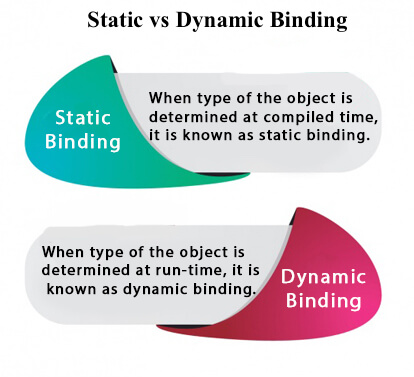Connecting a method call to the method body is known as binding.
There are two types of binding
- Static Binding (also known as Early Binding).
- Dynamic Binding (also known as Late Binding).
Understanding Type
Let’s understand the type of instance.
1) variables have a type
Each variable has a type, it may be primitive and non-primitive.
int data=30;
Here data variable is a type of int.
2) References have a type
class Dog{
public static void main(String args[]){
Dog d1;//Here d1 is a type of Dog
}
}
3) Objects have a type
| An object is an instance of particular java class,but it is also an instance of its superclass. |
class Animal{}
class Dog extends Animal{
public static void main(String args[]){
Dog d1=new Dog();
}
}
| Here d1 is an instance of Dog class, but it is also an instance of Animal. |
static binding
When type of the object is determined at compiled time(by the compiler), it is known as static binding.
If there is any private, final or static method in a class, there is static binding.
Example of static binding
class Dog{
private void eat(){System.out.println("dog is eating...");}
public static void main(String args[]){
Dog d1=new Dog();
d1.eat();
}
}
Dynamic binding
When type of the object is determined at run-time, it is known as dynamic binding.
Example of dynamic binding
class Animal{
void eat(){System.out.println("animal is eating...");}
}
class Dog extends Animal{
void eat(){System.out.println("dog is eating...");}
public static void main(String args[]){
Animal a=new Dog();
a.eat();
}
}
Output:dog is eating...
| In the above example object type cannot be determined by the compiler, because the instance of Dog is also an instance of Animal.So compiler doesn’t know its type, only its base type. |








Leave A Comment